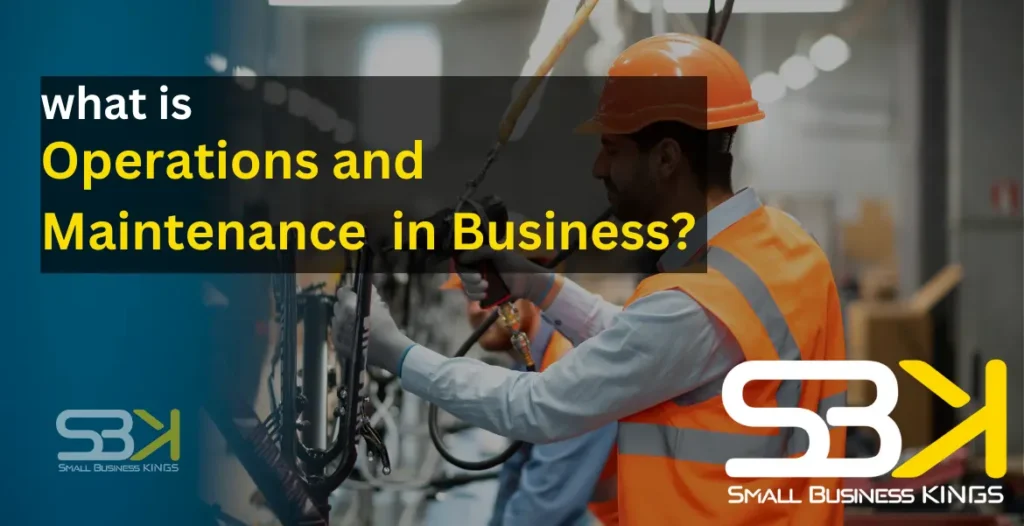In the world of business, Operations and Maintenance (O&M) play a vital role in ensuring smooth functioning, productivity, and longevity of assets.
O&M involves the management of various aspects within an organization to keep its operations running efficiently and effectively.
What is O&M?
Operations and Maintenance (O&M) in business refers to the management of facilities, equipment, and processes to ensure their efficient functioning.
It involves tasks such as equipment maintenance, facility management, process optimization, and adherence to health and safety procedures. O&M is crucial for minimizing downtime, reducing costs, and maximizing productivity.
It encompasses preventive and predictive maintenance, continuous improvement, and the use of technology to enhance efficiency. Effective O&M helps businesses remain competitive and meet customer expectations.
Importance of O&M in Business
The Importance of Operations and Maintenance (O&M) in business cannot be overstated. It ensures:
- Continuous Functioning: O&M keeps operations running smoothly, preventing disruptions and downtime.
- Cost Efficiency: Proper maintenance reduces costly repairs and extends the life of assets.
- Customer Satisfaction: Reliable operations lead to satisfied customers, enhancing reputation and loyalty.
- Safety Compliance: O&M ensures adherence to safety regulations, protecting employees and assets.
- Competitive Edge: Efficient operations give businesses a competitive advantage in the market.
Find Out More: What is Business As Usual in Business? Understanding BAU
Key Components of O&M
- Equipment Maintenance
One of the primary components of O&M is equipment maintenance. This involves regular inspections, repairs, and servicing of machinery and equipment to ensure they remain in good working condition. Proper maintenance helps prevent breakdowns, extends equipment life, and reduces the risk of accidents.
- Facility Management
Facility management is another essential aspect of O&M. It involves the upkeep and maintenance of buildings, infrastructure, and utilities. This includes tasks such as cleaning, repairs, security, and ensuring compliance with safety regulations.
- Process Optimization
O&M also focuses on optimizing processes to improve efficiency and productivity. This may involve streamlining workflows, eliminating bottlenecks, and implementing best practices to enhance overall performance.
- Health and Safety Procedures
Maintaining a safe working environment is paramount in O&M. Businesses must adhere to strict health and safety procedures to protect employees, customers, and assets. This includes conducting risk assessments, providing training, and implementing safety protocols.
O&M Strategies and Best Practices
Preventive Maintenance
This strategy involves regular inspections, servicing, and upkeep of equipment and facilities to prevent failures before they occur.
By identifying and addressing issues proactively, businesses can minimize downtime and reduce the risk of costly repairs.
Preventive maintenance schedules are typically based on equipment manufacturer recommendations and industry best practices.
Predictive Maintenance
Predictive maintenance utilizes data and analytics to predict when equipment is likely to fail. By monitoring factors such as equipment performance, temperature, and vibration levels, businesses can identify potential issues early and take corrective action before failures occur.
Predictive maintenance helps optimize maintenance schedules, minimize downtime, and extend the lifespan of assets.
Condition-based Maintenance
This strategy involves monitoring the condition of equipment in real-time to determine when maintenance is needed. Sensors and monitoring systems collect data on factors such as temperature, pressure, and performance indicators.
When predefined thresholds are exceeded or anomalies are detected, maintenance activities are triggered. Condition-based maintenance allows businesses to optimize maintenance schedules, reduce costs, and improve asset reliability.
Reliability-centered Maintenance (RCM)
RCM is a systematic approach to maintenance that focuses on identifying the most critical assets within a business and developing maintenance strategies to ensure their reliability.
It involves analyzing the consequences of equipment failures, prioritizing maintenance tasks based on risk, and optimizing maintenance activities to maximize asset performance and lifespan.
Total Productive Maintenance (TPM)
TPM is a holistic approach to maintenance that involves the entire organization. It aims to maximize the productivity of equipment and resources by involving operators, maintenance personnel, and management in maintenance activities.
TPM focuses on improving equipment reliability, reducing breakdowns, and eliminating waste through proactive maintenance practices and continuous improvement efforts.
Root Cause Analysis (RCA)
RCA is a problem-solving technique used to identify the underlying causes of equipment failures or performance issues. By investigating the root causes of problems, businesses can implement corrective actions to prevent recurrence.
RCA helps improve equipment reliability, optimize maintenance strategies, and enhance overall operational efficiency.
Asset Management
Asset management involves tracking and managing assets throughout their lifecycle, from acquisition to disposal. It includes activities such as inventory management, asset tracking, and maintenance scheduling.
Effective asset management ensures that assets are utilized efficiently, maintenance activities are optimized, and asset performance is maximized.
Implementing O&M in Your Business
1. Assessing Current Operations
- Start by conducting a thorough assessment of your current operations. Identify areas where maintenance practices are lacking or where improvements can be made.
- Evaluate the condition of your equipment, facilities, and processes to determine any existing issues or potential risks.
- Consider factors such as equipment age, maintenance history, and performance data to prioritize areas for improvement.
2. Developing an O&M Plan
- Based on your assessment, develop a comprehensive O&M plan outlining your goals, strategies, and action steps.
- Define specific maintenance tasks, schedules, and responsibilities for each aspect of your operations.
- Set performance metrics and benchmarks to measure the effectiveness of your O&M efforts.
- Allocate resources such as budget, manpower, and technology to support your O&M plan.
3. Training Employees
- Provide training to your employees on proper equipment operation, maintenance procedures, and safety protocols.
- Ensure that all employees understand their roles and responsibilities in implementing O&M practices.
- Offer ongoing training and development opportunities to keep employees up-to-date with the latest maintenance techniques and technologies.
4. Implementing Maintenance Procedures
- Establish preventive maintenance schedules for your equipment and facilities based on manufacturer recommendations and industry best practices.
- Implement predictive maintenance techniques, such as condition monitoring and analysis, to identify potential issues before they cause failures.
- Develop standard operating procedures (SOPs) for maintenance tasks and ensure they are followed consistently.
- Incorporate safety procedures and protocols into your maintenance practices to protect employees and assets.
5. Monitoring and Reviewing Performance
- Regularly monitor the performance of your O&M activities to ensure they are meeting your goals and objectives.
- Track key performance indicators (KPIs) such as equipment uptime, maintenance costs, and safety incidents.
- Conduct regular audits and inspections to identify areas for improvement and address any deficiencies.
- Use feedback from employees and stakeholders to continuously refine and improve your O&M practices.
The Role of O&M in Different Industries
- Manufacturing
In the manufacturing industry, O&M is essential for ensuring smooth production processes and minimizing downtime. Effective maintenance of equipment and machinery is critical to meeting production targets and delivering high-quality products.
- Energy
In the energy sector, O&M is crucial for maintaining power plants, renewable energy installations, and distribution networks. Proper maintenance of equipment and infrastructure is necessary to ensure uninterrupted supply and prevent costly breakdowns.
- Construction
Construction projects rely on effective O&M to ensure projects are completed on time and within budget. Proper maintenance of equipment, tools, and construction sites helps minimize delays and ensures safety for workers.
- Transportation
In the transportation industry, O&M is vital for maintaining vehicles, infrastructure, and logistics operations. Regular maintenance of fleets, roads, and transportation hubs is necessary to keep goods and people moving efficiently.
Challenges in O&M
- Cost Management
One of the main challenges in O&M is managing costs effectively. Businesses must balance the need for maintenance with budget constraints to avoid overspending while ensuring assets remain operational.
- Technological Advancements
Rapid technological advancements present challenges for O&M professionals. Keeping up with new technologies and implementing them effectively can be daunting, but it’s essential for maintaining competitiveness.
- Human Resource Management
Skilled personnel are crucial for successful O&M. Recruiting and retaining qualified employees, providing ongoing training, and ensuring proper staffing levels are all challenges faced by businesses in this area.
Benefits of Effective O&M
Increased Efficiency
Effective O&M leads to increased efficiency across all areas of business operations. By maintaining assets and optimizing processes, businesses can reduce waste, improve productivity, and enhance overall performance.
Cost Savings
Proper maintenance helps businesses avoid costly repairs and downtime. By identifying and addressing issues early, businesses can minimize the impact on operations and save money in the long run.
Enhanced Reliability
Regular maintenance ensures that equipment and facilities are reliable and available when needed. This reliability is essential for meeting customer demands and maintaining a competitive edge in the market.
FAQs
- What is the difference between operations and maintenance?
Operations involve the day-to-day activities of running a business, while maintenance focuses on ensuring that assets and facilities remain in good working condition.
- How often should preventive maintenance be performed?
The frequency of preventive maintenance depends on factors such as equipment type, usage, and manufacturer recommendations. Generally, it is performed at regular intervals, such as monthly, quarterly, or annually.
- What are some common challenges in implementing O&M practices?
Common challenges include budget constraints, resistance to change, and a lack of skilled personnel.
- How can businesses measure the effectiveness of their O&M efforts?
Key performance indicators (KPIs) such as equipment uptime, maintenance costs, and safety incidents can be used to measure the effectiveness of O&M efforts.
- Is O&M only relevant to large businesses?
No, O&M is essential for businesses of all sizes. Even small businesses can benefit from implementing O&M practices to improve efficiency and reliability.




